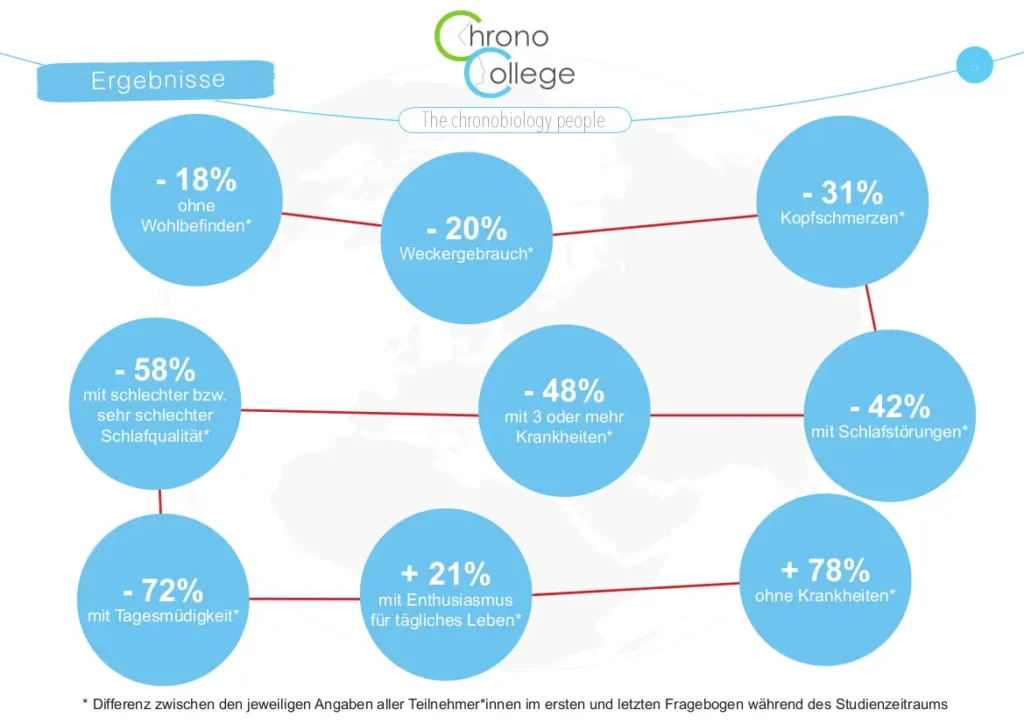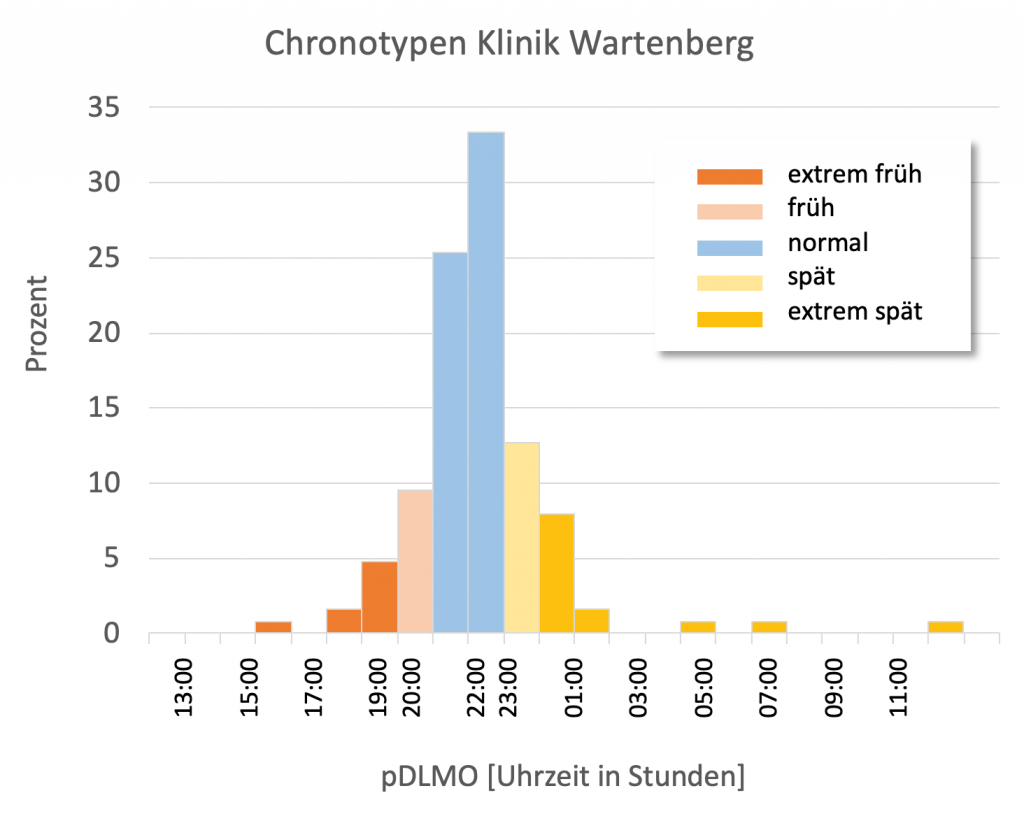
Innovation in shift work – It all started with my presentation on“Chronobiology in workforce scheduling” and a joint workshop with managers. Together with the Wartenberg Clinic, we developed the “Chronotype-oriented staff scheduling” project at the beginning of 2019. We are breaking new ground worldwide on this scale. The Charité blood test used for this has also never been used so extensively.
Initial situation – sleep disorders due to shift work
During a series of lectures I gave to decision-makers from business and the healthcare sector on behalf of the AOK Bayern, I had a subsequent discussion with the clinic management and those responsible for occupational health management. In the course of the discussion, the idea of optimizing shift times for chronotypes emerged. This was based on the results of regular employee surveys. The issue of “sleep disorders” was increasingly described as a burden, particularly among employees working shifts. In a subsequent workshop, the ideas were fleshed out and conceptually consolidated into an overall project entitled “Chronobiology in clinical practice”.
Goals
On the part of the employees:
- Reducing the risk of illness, especially in the area of mental stress (burnout, depression, psychosomatic consequences, etc.)
- Improvement of personal well-being
- Increase in the average duration of sleep
- Improving the quality of sleep
On the part of the company (based on the general objectives of the hospital’s internal OHM)
- Reduction in absenteeism
- Reduction of the error rate
- Increasing motivation
- Improving the care situation
- Strengthening employer branding
- Recruitment of skilled workers in particular. for the structural extension
The “COPEP” project in shift work
Chronobiologist Prof. Dr. habil. Thomas Kantermann from the FOM in Essen, and together with the “BodyTime” team led by chronobiologist Prof. Achim Kramer at the Charité in Berlin, we launched the first sub-project, the “Chronotype-oriented workforce scheduling” study, in July 2019. In the run-up to the event, Michael Wieden gave several presentations and talks to inform employees about the topic and the project process.

Milestones
- July 2019 – In-house KickOff Health Day in July 2019 together with the BodyTime team. Here we provided information about the project and recruited volunteers for an initial study. This and other measures ultimately led to over 130 employees signing up for voluntary chronotyping based on a blood test.
- October 2019 – Blood sampling and transportation of samples to the Charité by BodyTime as part of further internal health days.
- November 2019 – Sending (online) the results of the chronotyping to the participants based on the DLMO value determined.
- November 2019 – Interviews by us(aliamos GmbH) with the participants who had released the results for further processing in order to determine further times (e.g. travel times, morning/evening hygiene, childcare, etc.). We then added these times to the employees’ biological sleep time.
- December 2019 – Determination of a recommended working window as a basis for further chronotype-oriented shift and personnel deployment planning by us(aliamos GmbH)
- January – March 2020 – Preparation of the chronotype-oriented personnel deployment plans by the Wartenberg Clinic.
- 01.04.2020 – Start of the new working hours
- 30.07.2020 – End of the study period
- Since 08.2020 Scientific evaluation
- Presentation of the results in June 2021
July 2019 – In-house KickOff Health Day in July 2019 together with the BodyTime team. Here we provided information about the project and recruited volunteers for an initial study. This and other measures ultimately led to over 130 employees signing up for voluntary chronotyping based on a blood test.
Results and successes
58% less with poor sleep quality and
72% less with daytime sleepiness
20% reduced alarm clock use
and much more.
The complete list of results incl. of the project description can be found in our white paper for download here.

Chronotype distribution

Last but not least, by evaluating the blood tests, the clinic now has an overview of what makes some of its employees “tick”. For every project, this is the starting point for all further measures in shift work and traditional working hours. The graph on the right shows that the distribution is clearly grouped around a DLMO between 9 p.m. and 11 p.m. Such cumulation was to be expected. However, the late types are particularly interesting. Some employees have a DLMO of later than 01.00 hours. This means that their biological night takes place between 2.30 am and 10.30 am. There are even people in the test field whose biological after-effects will become apparent later. In this case, these are extreme late types that even have a biological night between 6.30 am and 2.30 pm or 8.30 am and 4.30 pm. On the other hand, there are also extremely early types whose biological night sometimes begins at 4.30 pm and ends around 4.30 am. The biological night therefore does not necessarily coincide with the earthly night.
Thus, it can actually be shown that such extreme types can also be found in companies. These are important findings, particularly for the allocation of early and night shifts as part of shift work.
In addition to the measurable improvements, there are also general effects that have arisen simply due to the fact that the topic is being discussed intensively at various levels by the clinic management.
Raising awareness, also in the context of shift work
Up to now, improvements in shift work have primarily related to the type of rotation. What makes the employees themselves tick was predominantly irrelevant. The most important prerequisite is therefore the conviction of the company management. It was only by generating enthusiasm among decision-makers in advance for the opportunities that lie in this topic that it was possible to create awareness within the company and be able to embark on this first stage of the study. Both the participants and the decision-makers now see many things with completely different eyes. This alone can also be considered a success.
Information
Changes in shift work are a very sensitive undertaking. Chronobiology is a field that is still virtually unknown to the public and, in addition to opportunities, also harbors potential for anxiety if some things are only considered superficially or not explained. The number of participants in this project was achieved through intensive information from us (aliamos GmbH), the BodyTime project group, the scientific director Prof. Kantermann, as well as the company’s internal project team. Considerate information is needed to attract people to undergo blood testing. The personal interviews were therefore particularly important in order to be able to identify any potential problems. also be able to assess fears on the basis of personal situations and reduce them accordingly.
Further course
The study itself is “only” part of the planned overall project “ChronoClinic – Chronobiology in the Clinic” at the Wartenberg Clinic, which also includes topics such as lighting and nutrition. However, it provides a basis for shaping.
A follow-up project was implemented from September 2021 to April 2022. More than 50 other employees were chronotyped with the new BodyClock RNA test based on hair roots/hair follicles and then coached by me and my wife on the basis of the respective result report. Over 80% were now also prepared to share their results with the clinic management in order to optimize working and shift times based on the chronotypes. The “COPEP®” system we developed for this purpose was refined after the first study, which has already led to positive effects (end of January 2022).
- Greater acceptance when releasing data for workforce scheduling,
- more positive personal effects through individual coaching sessions etc.
You can find out more about this second project and the results here.
Press & Media
WDR report in the program “Markt”, Kugel2 on 22.06.2022. (from minute 28.30)
Project partners
FOM, University of Applied Sciences for Economics and Management in Essen
Charité Berlin/Bodytime project group (Prof. Achim Kramer)
BGW – Employer’s Liability Insurance Association for Health Services and Welfare Care
Zu allen Themen biete ich Online-Vorträge und Online-Coachings an. Du findest Buchungsmöglichkeiten hier. | Du willst Feedbacks meiner Kunden sehen? Eine Auswahl habe ich hier zusammengestellt. | Abonniere mein ChronoCoach-Update, den Newsletter für Ausgeschlafene |